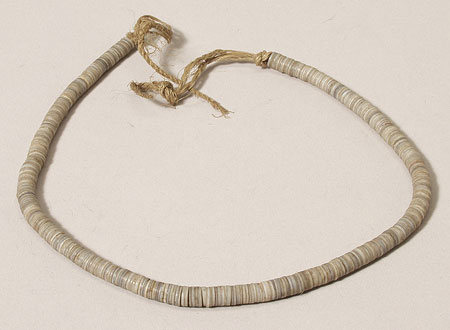Accession Number:
1946.8.102
Country:
Sudan
Region:
[Southern Sudan] Bahr el Jebel? Eastern Equatoria?
Cultural Group:
Lotuko [Otuho]
Date Made:
By 1946
Materials:
Shell , Plant Fibre
Process:
Perforated , Twisted , Tied , Strung
Dimensions:
Length of untied string = 507 mm, Diam beads = 5.5 mm, Diam cord = 1.5 mm [RTS 5/5/2004].
Weight:
18.7 g
Other Owners:
Presumably collected by Charles Gabriel Seligman and his wife Brenda Zara Seligman while conducting research in the Southern Sudan. They entered Lokoiya and Lotuko territory in January 1922, with their itinerary including visits to the Bellinian rest hous
Field Collector:
Charles Gabriel Seligman ? & Brenda Zara Seligman
PRM Source:
Brenda Zara Seligman
Acquired:
Donated August 1946
Collected Date:
By 1946
Description:
Neck or limb ornament made from a cord of two strands of twisted and loosely plaited light yellowish brown fibre (Pantone 466C), on which between 400 to 420 disc beads shaped from
Achatina
shell have been strung.
It is impossible to make an accurate count of the number of beads, as some appear to be stuck together, while others that are now separate may be sections that have laminated off an existing bead.
These beads have a flat upper and lower surface, straight sides, and a medium sized thread hole through the centre.
They range in colour from white to a slightly bluish gray (Pantone 428C), and some are extremely thin, making them partially translucent.
Although they vary in thickness, the group has very similar diameters.
The cord has been knotted against the terminal beads; one end is then loose and beginning to unravel, the other divides into two strands and then is knotted a second time close to its end.
The untied string has an extended length of 507 mm and weighs 18.7 grams; the beads have a diameter of 5.5 mm and a thickness of 1 mm or less, while the cord has a diameter of 1.5 mm.
This object was amongst material donated to the Pitt Rivers Museum in 1940, from the collection of Charles Gabriel Seligman and his wife Brenda Zara Seligman. It was collected by them from the Lotuko while conducting research in the Southern Sudan during 1922. Although they do not specify the provenance of the object, their personal diaries provide a record of their movements, showing that they entered Lokoiya and Lotuko territory in January 1922, with their itinerary including visits to the Bellinian rest house (11th-13th), a resthouse on the Mongalla-Torit road (14th), Ngala and Hangare Lokoiya (15th), Lokoiya (17th), Lokila (18th), Lobula (19th), Torit (20-23rd), Lebalwa (24th), Tarangala (25th January to 4th February), Idumela and Lugurn (4th February), Lopi (6th), Kiri Kiak (7th), Legoprof (10-16th), Lopir and Lomu (16th), Losua village (17th) and then back to Torit on February 20th. After that, they ventured into Acholi territory, then back into Torit and the surrounding area from March 5th to around March 15th (based on information collected by Fran Larson from the unpublished diaries of C.G. and B.Z. Seligman, in the Archives of the London School of Economics, Seligman manuscripts, files 1/4/1 and 1/4/6).
Achatina is a species of gastropod; the three main varieties are Achatina fulica (East African land snail), Achatina marginata (West African Land Snail) and Achatina Achatina (Tiger Snail). The Achatina fulica is the smallest of these, with a shell 3-4 inches in length (Source: http://exoticpets.about.com/cs/rarespecies/p/landsnails.htm).
Rachael Sparks 28/9/2005.
This object was amongst material donated to the Pitt Rivers Museum in 1940, from the collection of Charles Gabriel Seligman and his wife Brenda Zara Seligman. It was collected by them from the Lotuko while conducting research in the Southern Sudan during 1922. Although they do not specify the provenance of the object, their personal diaries provide a record of their movements, showing that they entered Lokoiya and Lotuko territory in January 1922, with their itinerary including visits to the Bellinian rest house (11th-13th), a resthouse on the Mongalla-Torit road (14th), Ngala and Hangare Lokoiya (15th), Lokoiya (17th), Lokila (18th), Lobula (19th), Torit (20-23rd), Lebalwa (24th), Tarangala (25th January to 4th February), Idumela and Lugurn (4th February), Lopi (6th), Kiri Kiak (7th), Legoprof (10-16th), Lopir and Lomu (16th), Losua village (17th) and then back to Torit on February 20th. After that, they ventured into Acholi territory, then back into Torit and the surrounding area from March 5th to around March 15th (based on information collected by Fran Larson from the unpublished diaries of C.G. and B.Z. Seligman, in the Archives of the London School of Economics, Seligman manuscripts, files 1/4/1 and 1/4/6).
Achatina is a species of gastropod; the three main varieties are Achatina fulica (East African land snail), Achatina marginata (West African Land Snail) and Achatina Achatina (Tiger Snail). The Achatina fulica is the smallest of these, with a shell 3-4 inches in length (Source: http://exoticpets.about.com/cs/rarespecies/p/landsnails.htm).
Rachael Sparks 28/9/2005.
Primary Documentation:
Accession Book Entry
[p.
146] - MRS.
SELIGAMN, COURT LEYS, TOOT BALDON.
[p.
147] 1946.8.102 - ANGLO-EGYPTIAN SUDAN, LOTUKO-SPEAKING TRIBES.
Short string (13 1/4") of shell-disc beads, presumably made from Achatina shell.
Card Catalogue Entry - There is no further information on the catalogue card [RTS 28/5/2004].
Pitt Rivers Museum label - Shell beads, presumably of Achatina shell. LOTUKO, A.E. SUDAN. d.d. Mrs Seligman 1946.8.102 [tied to object; RTS 5/5/2004].
Card Catalogue Entry - There is no further information on the catalogue card [RTS 28/5/2004].
Pitt Rivers Museum label - Shell beads, presumably of Achatina shell. LOTUKO, A.E. SUDAN. d.d. Mrs Seligman 1946.8.102 [tied to object; RTS 5/5/2004].



